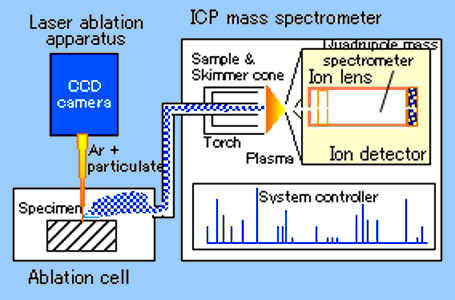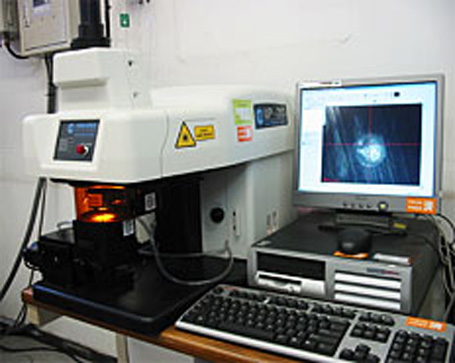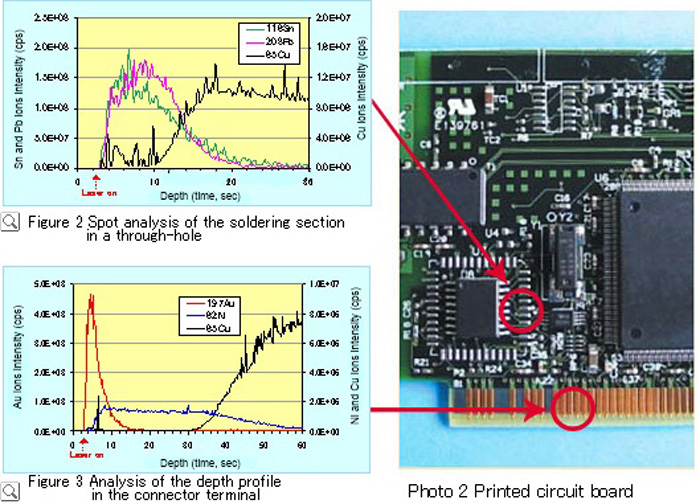Trace Analysis
Laser Ablation Inductively Coupled Plasma Mass Spectrometry (LA-ICP-MS)
Outline and Principle of Laser Ablation Inductively Coupled Mass Spectrometry
Laser Ablation (LA) is a method to vaporize a solid sample by irradiating with a laser beam enabling to remove a very small area (approximately 5 μm) of the sample or only top surface area of the sample which is then swept into the plasma via a helium carrier gas. The ICP-MS uses the mass spectrometer which functions by passing small amounts of material into plasma, a super-heated gas, which ionizes the sample material at around 9000 K. The strongest point of the ICP-MS is high sensitivity and accurate quantification of components. For example, it can quantify the elements in aqueous samples at a level of several parts per trillion (fg in the absolute quantity) and is used in the quantitative analysis of elements in electronic materials. That is, LA-ICP-MS is the induced coupled plasma mass spectrometry in which the sample is vaporized in fine solid with laser irradiation and continuously analyzed with ICP-MS with high sensitivity and is quite different from the conventional mass spectrometry.
Main Components of Instrument
-

Figure 1 Configuration of laser ablation induced coupled mass spectrometer (LA-ICP-MS) -

Photo 1 Laser ablation apparatus
Usage Examples
Analysis of Spots and the Surface of Samples

Figures above are the plots of the ion intensity vs. depth in analysis of the portion of the print circuit board with LA-ICP-MS and Figure 2 indicates bonding of copper wiring with the tin-lead (Sn-Pb) solder in the through-hole. This measurement takes only a range of 30 seconds. The ion intensity ratio measured can also determine the concentration of those ions. The analysis suggests the bonding solder contains 30% lead (Pb), which is a common material as a solder.
Figure 3 demonstrates the analysis of connector terminals as an example of the profile analysis. The analysis indicates the connecter terminal is treated with nickel (Ni) and gold (Au) on the copper wiring. The sputtering depth with laser is in a range of 0.02 μm/laser irradiation giving the depth resolution of submicron.
Analysis of Hazardous Elements in Materials Regulated by WEEE and RoHS


The LA-ICP-MS can be applied not only to the analysis of inorganic materials such as glasses, ceramics, and metals but also to the analysis of organic materials such as plastics in a form of solid. Table 1 shows the quantitative analysis of certain heavy metals in plastics using the standard specimen containing heavy metals in polyethylene (Belgian Cancer Registry (BCR) standard specimen). The calibration curve used is illustrated in Figure 4.
JFE-TEC can provide not only the analysis service based on the use of the calibration curve for quantification but also the semi-quantitative analysis for the materials and components in which the standard specimen and the calibration curve are unavailable utilizing the strength of the mass spectrometry.
JFE-TEC prepares and markets the "Reference material for the analysis of hazardous components in plastics" complying with the RoHS Directive in EU.
Characteristics of LA-ICP-MS
- High-sensitivity and rapid analysis
- Linear, wide dynamic range
- Simultaneous analysis of multi-elements
- Direct analysis of any kind of solid samples (regardless of conductivity or non-conductivity)
- Little requirement for sample pretreatment
- Spot analysis and surface analysis


